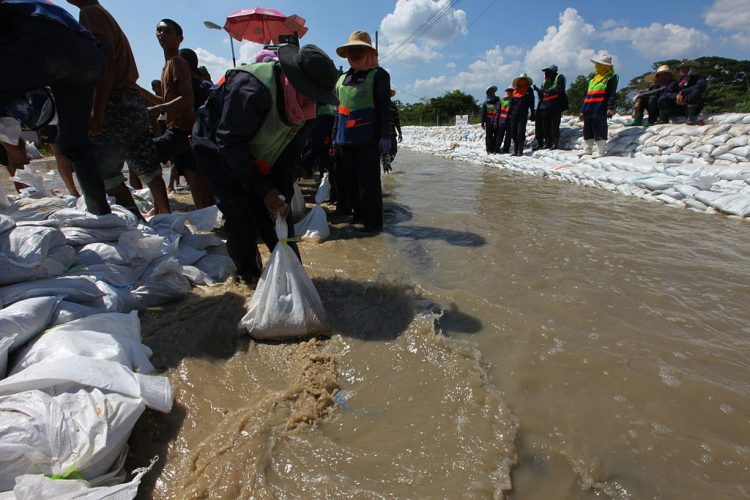Asia’s coasts to experience most extreme weather

A flood in Sai Mai, Bangkok, Thailand in 2011. People living in coastal Asia are likely to suffer the most by extreme weather conditions causing floods and land losses. Copyright : Wikimediacommons
Unbearable heat waves, typhoons of unprecedented speeds and flash floods have been an increasing occurrence globally. It’s not just a coincidence that these extreme weather events have been happening more frequently, said researchers and scientists at the Common Future under Climate Change conference held in Paris in July.
Hundreds of millions of people will be affected by coastal flooding and land loss as global temperatures rise, icecaps melt and sea levels rise. Cities will also suffer from heat stress, extreme precipitation, inland and coastal flooding, as well as drought and water scarcity, according to the report “Climate Change 2014: Impacts, Adaptation and Vulnerability”.
Historical climate projections for the Indian subcontinent suggest an overall increase in temperature by two degrees, which has resulted in a noticeable rise in heat waves and hot days.
Sumetee Pahwa Gajjar, who leads climate change research at the Indian Institute for Human Settlements, has conducted a regional diagnostic study for the critical risks and impacts of climate change in the semi-arid regions of Maharashtra, Karnatak and Tamil Nadu states in south-western and peninsular India. She found that rising occurrences of heat waves and hot days affected the health sector, mainly due to an increased outbreak of diseases and increased risk of heat stress. They also placed a big strain on the agricultural sector as well as on livestock and fisheries.
Francis Zwiers, director of the Pacific Climate Consortium, says human actions, such as the burning of fossil fuels, have increased the odds of extreme weather occurrences.
Events that used to happen every 25 years now happen every 15, he explains.One example is the European heat wave of 2003, during which 35,000 people died. It was the most extreme event of its kind since 1500 AD. In May 2015, India was struck by a severe heat wave that killed more than 2,500 people.
“Heat waves that [were once] expected to occur twice a century [are now], in the early 2000s, expected to occur twice a decade. Human influence has very likely at least doubled the likelihood of such an event,” says Peter Stott from the Met Office Hadley Centre, U.K.
While it is all very new, research is examining weather models for future climates to show the probability of extreme events.
A recent study published in June 2015 in Nature Climate Change used 25 climate computer models to test the connection between global warming and extreme weather occurrences. It found that man-made global warming is responsible for about 75% of all hot-temperature extremes worldwide in the past 100 years and for about 18% of heavy rainfall. The study says climate change will cause higher percentages of extreme weather in future decades. For example, by the middle of this century, if temperatures continue to rise, about 95% of all heat waves and around 40% of precipitation extremes will be due to human influence.
Past research from the United Nations' Intergovernmental Panel on Climate Change has also shown that heat waves and heavy precipitation can be attributed in some part to global warming.
However, it is hard to confirm a distinct correlation. Climate systems are very complex and natural variability makes it difficult to separate out human influence on extreme weather events from other factors. In addition, extreme weather is relatively rare and it can take a long time to identify significant trends.
“Extreme weather attribution, as the field is called, is still in its infancy, so its methods continue to undergo scrutiny,” says Dr Sarah Perkins of the University of New South Wales in the U.K.
Adaptation has proven hard, especially in poverty stricken regions.
“Barriers to adaptation arise from resource intensive development pathways, flawed governance mechanisms, inadequate information and socio-cultural characteristics,” says India’s Sumetee Pahwa Gajjar.
Results like this demonstrate the importance of rallying the world’s biggest CO2 emitters to submit goals and deadlines for lowering their emission outputs. This is a topic that will be ironed out in the upcoming COP21 to be held in Paris in December.
By Aya Lowe
Media Contact
All latest news from the category: Earth Sciences
Earth Sciences (also referred to as Geosciences), which deals with basic issues surrounding our planet, plays a vital role in the area of energy and raw materials supply.
Earth Sciences comprises subjects such as geology, geography, geological informatics, paleontology, mineralogy, petrography, crystallography, geophysics, geodesy, glaciology, cartography, photogrammetry, meteorology and seismology, early-warning systems, earthquake research and polar research.
Newest articles

Compact LCOS Microdisplay with Fast CMOS Backplane
…for High-Speed Light Modulation. Researchers from the Fraunhofer Institute for Photonic Microsystems IPMS, in collaboration with HOLOEYE Photonics AG, have developed a compact LCOS microdisplay with high refresh rates that…

New perspectives for material detection
CRC MARIE enters third funding period: A major success for terahertz research: Scientists at the University of Duisburg-Essen and the Ruhr University Bochum have been researching mobile material detection since…

CD Laboratory at TU Graz Researches New Semiconductor Materials
Using energy- and resource-saving methods, a research team at the Institute of Inorganic Chemistry at TU Graz aims to produce high-quality doped silicon layers for the electronics and solar industries….



